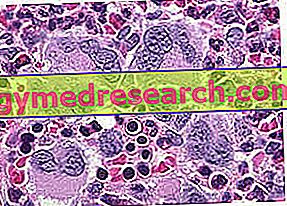Generality
Myelofibrosis is a bone marrow disease. Particularly striking is haemopoietic stem cells, used for the production of red blood cells, white blood cells and platelets.

Today, numerous therapeutic options exist for myelofibrosis. Although it is possible to replace the defective bone marrow thanks to a transplant from a donor, it is usually preferred to opt for a less invasive therapeutic intervention, aimed at alleviating the entire symptomatology.
Brief reference to the bone marrow
Bone marrow is a soft tissue found inside many bones of the human body. Considered a real organ, it mainly deals with producing blood cells (red blood cells, white blood cells and platelets). Its action must be constant during the course of life, as blood cells must be replaced periodically with new elements.
BLOOD CELL PRODUCTION
Hematopoiesis (or hematopoiesis ), ie the production of erythrocytes (red blood cells), leukocytes (white blood cells) and platelets, starts from the so-called hematopoietic (or hematopoietic ) stem cells . These are nothing but very gifted progenitor cells, capable of continually replicating and of facing different destinies.
- Red blood cells : they carry oxygen to the tissues and organs of the body.
- White blood cells : they are part of the immune system and defend the body from pathogens and from what can harm you.
- Platelets : they are among the main actors of coagulation.
What is myelofibrosis?
The term myelofibrosis refers to a serious and complex bone marrow disease that alters the process of hematopoiesis. In fact, in the blood of individuals with this disease, the number of blood cells is different from normal.

Figure: hematopoiesis starting from totipotent stem cells. From these derive different types of stem cells, including hematopoietic ones. Hematopoietic stem cells have the gift of continually replicating and of choosing whether to become red blood cells, white blood cells or platelets . From the site: www.liceotorricelli.it
All this leads to the formation, deleterious, of fibrous tissue instead of the one that usually composes the bone marrow. With this replacement of tissues, the productive capacity of the bone marrow is further reduced, therefore of red blood cells, white blood cells and platelets.
IS IT A TUMOR?
Myelofibrosis is a rare blood tumor, belonging to the so-called chronic myeloproliferative neoplasms (once called chronic myeloproliferative diseases); polycythemia vera (mainly characterized by an abnormal increase in red blood cells) and essential thrombocythemia (mainly characterized by a pathological increase in the number of platelets) also belong to this group.
Epidemiology
Myelofibrosis is a fairly rare pathology, however its exact incidence is unknown. It can affect individuals of any age, although there is a greater chance of getting sick from the age of 50-60.
It is more common among whites and Ashkenazi Jews.
Causes
The precise cause responsible for myelofibrosis has not yet been fully clarified. The involvement of a gene known as JAK2 in the DNA of hematopoietic stem cells is now certain. Once this mutation appears, it is transmitted to all the daughter cells, in particular to the red blood cells, altering their functions.
The absence, in the bone marrow, of healthy and efficient hematopoietic cells causes the formation of fibrous tissue devoid of any productive activity.
GENE JAK2 AND MYELOFIBROSIS
The JAK2 gene has a fundamental role in the growth and division of cells, especially those of blood stem cells. This explains why its malfunction has a dramatic impact on hematopoiesis.
The discovery of the link between the JAK2 gene and myelofibrosis is fairly recent and still has some pending points. According to data collected by the researchers, about half of the patients have a mutation of JAK2; this mutation makes the JAK2 gene constantly active and alters the relationships between mutated and adjacent cells.
NB: a genetic mutation is a stable variation or modification of DNA, so that the body could develop diseases.
FORMS OF MYELOFIBROSIS
There are two forms of myelofibrosis: primary and secondary.
- Primary myelofibrosis is the form that arises due to the aforementioned genetic mutation of JAK2.
- Secondary myelofibrosis, on the other hand, is a complication that arises following other pathological conditions, such as essential thrombocythemia and polycythemia vera .
RISK FACTORS
While the precise causes of myelofibrosis are still uncertain, on the other hand the risk factors have been delineated with certainty.
- Advanced age . It is true that myelofibrosis can occur at any age, but it is equally true that the individuals most affected are people aged 50-60 and above.
- Some blood disorders . Diseases such as thrombocythemia and polycythemia vera can trigger various complications, including myelofibrosis.
- Exposure to certain preparations / chemicals . Coming into contact with industrial products such as toluene and benzene for a prolonged time can cause myelofibrosis.
- Exposure to radiation . Bomb and atomic / nuclear disaster survivors are very likely to develop cancer, including myelofibrosis. Furthermore, between 1920 and 1950, the use, in diagnostic medicine, of a radioactive contrast agent, known as torotrasto, caused several individuals to become ill.
Symptoms and Complications
To learn more: Myelofibrosis symptoms
Myelofibrosis has a very slow course, with symptoms that - from almost imperceptible, at the beginning - become evident and very debilitating at an advanced stage.
The progressive productive inability of the bone marrow causes anemia (lack of red blood cells), sometimes leukopenia (lack of white blood cells) and thrombocytopenia (lack of platelets), as well as a series of signs directly related to these pathological conditions, namely:
- Feeling tired and weak
- Shortness of breath
- Enlarged spleen (splenomegaly)
- Enlarged liver (hepatomegaly)
- Skin pallor
- Easy onset of hematomas and bleeding
- Night sweats
- Temperature
- Recurrent infections
- Bone pain
NB: leukopenia and thrombocytopenia are less frequent than anemia (which instead is always present) and appear at a later stage of the disease.
WHOLESALE MILZA OR SPLENOMEGALIA
Splenomegaly (or enlarged spleen ) is one of the main signs of myelofibrosis (affecting about 90% of patients), so its establishment deserves special attention.

The characteristic expressions of splenomegaly are the pain and the sense of sub-rib fullness, in the left side of the body. These sensations are particularly pronounced when the stomach, intestines and bladder are full.
WHEN TO REFER TO THE DOCTOR?
At the beginning, myelofibrosis is asymptomatic, therefore difficult to suspect.
However, as soon as the symptoms listed above appear, it is advisable to consult your doctor for detailed examinations.
COMPLICATIONS
The complications that may arise in patients with myelofibrosis are different; they depend largely on the reduced production capacities of the bone marrow and only to a lesser extent on splenomegaly.
- Portal hypertension . It is an increase in pressure at the portal vein level; vein that connects spleen and liver. It occurs due to the stagnation of blood inside the spleen. Helps to make splenomegaly worse.
- Pain . The enlarged spleen causes persistent pain.
- Extramedullary hematopoiesis . This process is increasingly amplified and involves other organs, such as the lungs, lymph nodes and spinal cord. In fact, even these organs receive hematopoietic stem cells and suffer damage similar to those seen for liver and spleen.
- Frequent bleeding . Bone marrow, due to fibrosis, no longer produces functional platelets, which are fundamental for blood clotting. Furthermore, the spleen and liver retain blood cells within them.
- Pain in the bones and joints . The fibrous substitute tissue "hardens" the bone marrow and recalls the cells involved in the inflammatory process. This causes an extended painful sensation, both to the bones and to the joints.
- Gotta . Advanced myelofibrosis can lead to increased production of uric acid, which, in these conditions, can precipitate, accumulate in the joints and cause pain.
- Acute leukemia . Some individuals may develop a form of myeloid leukemia, which is a malignant tumor of the bone marrow.
Diagnosis
To establish the diagnosis of myelofibrosis with certainty, a physical examination, a complete blood test and a bone marrow biopsy are essential. Furthermore, to understand the causes and / or identify any complications, it is also possible to carry out a genetic test and some radiological tests .
PHYSICAL EXAMINATION
During the physical examination, the doctor asks the patient to describe their symptoms. Then he visits it first, measuring the blood pressure levels and the volume of the lymph nodes and abdomen. If the spleen and liver are swollen, these can also be identified by palpation.
BLOOD ANALYSIS
On a blood sample taken from the patient, the so-called blood cell count is performed. An individual with myelofibrosis has a low number of red blood cells (thus anemia), and abnormal levels of white blood cells and platelets.
BIOPSY OF BONE MARROW

Figure: bone marrow extraction for biopsy. From the site: www.macmillan.org.uk
It consists of the collection of bone marrow and its analysis in the laboratory. It represents the examination of choice if you want to confirm the suspicions of myelofibrosis that emerged from the previous exams.
The sample is extracted from the iliac bone (from the hip), by means of a syringe and after local anesthesia.
The procedure lasts 15-20 minutes in all and the patient can feel a slight pain in the days following the extraction.
GENETIC TESTS AND RADIOLOGY
Genetic tests are useful if the doctor suspects primary myelofibrosis, supported by a genetic mutation of JAK2.
Radiology exams, such as nuclear magnetic resonance and X-rays, provide additional information on the pathological state of the patient.
Treatment
To treat myelofibrosis, one must act at the root and replace the ineffective bone marrow by transplant.
However, this therapy is at high risk for the patient, so very often alternative, fairly effective treatments are used, which aim to moderate and alleviate the main symptoms of myelofibrosis. The therapeutic offer, having the aforementioned purposes, is extensive and the choice of one treatment, rather than another, depends on the type of myelofibrosis and on the severity of the conditions in which the patient is.
ASYMOMATICAL INITIAL PHASE
An initial myelofibrosis is asinatomatic, so the diagnosis is random and usually occurs after a common routine blood test. In these situations, the patient must not undergo any treatment; the only care is to carry out periodic checks to monitor the progress of the disease.
TREAT ANEMIA
Lack of red blood cells is one of the main and most debilitating symptoms. To relieve anemia, use:
- Periodic blood transfusions .
- Androgen-based therapy . Male hormones promote the production of red blood cells. However, its application depends on the causes of myelofibrosis and is not free from side effects (liver damage and masculinization in women).
- Erythropoiesis stimulators: stimulate the production of red blood cells; erythropoietin, for example, is a hormone normally produced by the kidney that stimulates the production of erythrocytes in the bone marrow.
- Thalidomide . Associated with other drugs, such as lenalidomide, it elevates the number of erythrocytes and reduces splenomegaly.
TREAT THE WHOLESALE MILZA. CHEMOTHERAPY AND RADIOTHERAPY
Splenomegaly can be treated in different ways, depending on the severity of the situation.
If it is not serious, the patient can undergo chemotherapy . This is an anticancer therapy, which destroys inefficient blood cells present inside the spleen.
If splenomegaly is severe and chemotherapy has given no result, the solution is surgical removal of the spleen .
Finally, if the removal intervention was impossible (due to health problems, related to the patient), another anti-cancer treatment is used, radiotherapy . Like chemotherapy, it also acts by reducing the number of ineffective blood cells.
| Side effects | |
Chemotherapy | Destruction of white blood cells; toxic effects on the heart |
Surgical removal surgery | Easy infections; venous thrombosis |
Radiotherapy | Exposure to high-energy radiation; fatigue; skin irritation |
THE INHIBITOR OF THE GENE JAK2
The JAK2 deleterious gene inhibitor is a newly discovered and recently approved drug known as ruxolitinib . This type of treatment is applied in cases of primary myelofibrosis, for which the genetic mutation of JAK2 has been found.
THE BONE MARROW TRANSPLANTATION
By bone marrow transplantation, we mean an allogeneic transplant (ie coming from a compatible donor) of hematopoietic stem cells .
This is a rather invasive and risk-free therapeutic procedure, so much so that it is applied only if strictly necessary.
Prognosis
The prognosis related to myelofibrosis varies from patient to patient.
It is positive for those who are discreetly responding to care. Instead, it is negative for those who, unfortunately, do not get appreciable therapeutic benefits.
In both cases, however, the quality of life is negatively affected, given that an individual with myelofibrosis must continually take drugs and monitor their state of health with periodic examinations.



